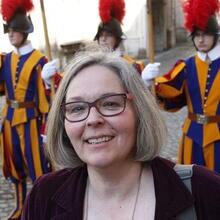VATICAN CITY (CNS) -- Pope Francis has invited a community of Benedictine nuns from Argentina to move into the Mater Ecclesiae Monastery in the Vatican Gardens, renewing the building’s purpose as home to a cloistered community of women dedicated to supporting the pope’s ministry with their prayer.
St. John Paul II had established the monastery in 1994 with the intention of inviting different contemplative orders to live there for a period of three to five years with “the ministry of prayer, adoration, praise and reparation” in silence and solitude “to support the Holy Father in his daily care for the whole church.”
The last community, a group of Visitation nuns, left in November 2012, and a remodeling project began. A few months later, Pope Benedict XVI announced his resignation. The monastery became home to the retired pontiff and a small staff until Pope Benedict died Dec. 31, 2022.
The Vatican press office confirmed Nov. 13 that Pope Francis, in a letter dated Oct. 1, decided that “the Mater Ecclesiae Monastery would return to its original purpose: that contemplative orders support the Holy Father in his daily care for the whole church, through the ministry of prayer, adoration, praise and reparation, thus being a prayerful presence in silence and solitude.”
Before becoming Pope Benedict’s residence, it was home to communities of Poor Clare nuns, then Discalced Carmelites, Benedictines and the Visitation nuns.
Pope Francis invited the Benedictine nuns of the Abbey of St. Scholastica in Victoria, Argentina, to staff the monastery and they accepted, the press office said. “The six nuns who, according to the statutes, will form the monastic community will begin living in the monastery in early January.”
Before it was remodeled for Pope Benedict, the monastery -- a building of about 4,300 square feet -- had 12 monastic cells, a chapel, kitchen, dining room and common room. The complex, mostly hidden from view by a high fence and hedges, included a vegetable garden. The whole complex occupies about 8,600 square feet halfway a hill to the west of the apse of St. Peter’s Basilica.
While contemplative nuns generally enter a monastery with the intention of remaining at that convent for life, St. John Paul set up a rotation system for the Vatican monastery to honor and highlight the variety of women’s religious orders dedicated totally to prayer and manual labor. Before becoming Pope Benedict’s residence, it was home to communities of Poor Clare nuns, then Discalced Carmelites, Benedictines and the Visitation nuns.
An article in the Vatican newspaper announcing the foundation of the monastery in 1994 said, “The presence of a community completely dedicated to contemplation in a strict papal cloister near the See of Peter is an exemplary indication that contemplative life represents a richness and a treasure which the church does not intend to renounce.”
A small core of the current building began its life as the gardener’s house and included some ruins of a medieval tower that may have been part of the Vatican walls at the turn of the 13th century. In 1960, Blessed John XXIII invited his new archaeological research institute to have its base there. Before the first cloistered community took up residence in 1994, an addition consisting mainly of a chapel was added.
St. John Paul named it “Mater Ecclesiae,” in honor of Mary, Mother of the Church.







